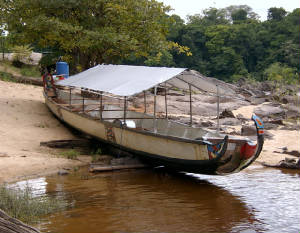
|
| Our boat before the fated trip. Pulled out for hull repairs. |
The
Fated Supply Trip
by Bryan
On a Saturday
afternoon in early March our boat came up the river from Boskamp with two people, the captain and his mate and a full cargo
of food, tools, and wood. The food feeds the workers and us; the wood and tools are for constructing the foundation for a
new building. We have two contractors here from the US for the month of March directing the work. The foundation needs to
be completed while they are here and everything that they need must come 100 miles up river by boat.
On this fateful
day our captain thought it would be a good idea if he could bring the boat up the rapids closer to the building so we can
unload the wood. There are rapids at the southern end of Foengoe Island. The camp called Raleighvallen where we live is located
here. When the water level is high the boats can go up the rapids to unload just
below the construction site. When the river level is low boats pull in just below
camp and supplies are carried a longer distance. As the canoe was filled with
more than a ton of supplies the captain tried a run up the rapids. On land, we
listen for the sound of the boat as we know we must all go down to help unload. This
day we heard the run up the rapids and then a terrible silence quickly followed by yelling. The boat had hung up on a rock and then the engine failed. For
two seconds it hung there, then tipped spilling wood into the fast current. Suddenly
it capsized throwing the people, two dozen bottles of turpentine and all our food in the river.
The captain
managed to stay with the boat and was soon walking on the upturned hull. Everyone
on the island was in the water pulling floating objects to shore or manning all the boats available. None of us thought about electric eels then. Several people
swam to the boat and tried to right it so that a smaller motorized canoe could pull it to shore. More wood spilled out as we rolled it. Some visitors with a motorized inflatable boat picked up the turpentine
bottles; luckily they floated. So did lots of other things: a big fuel drum,
a plastic tool chest, an ice chest with frozen chicken and most of the wood. The
captain was must concerned about the engine; it was brand new and very expensive. It
had fallen off the stern but was found still tethered to the rope that is always tied off on one of the boat ribs for this
very purpose.

|
| The boat after capsizing |
Several important
things were gone: the mate’s bag with his pay, the roof supports and tarp that protect us from sun and rain, the new
$500 rebar cutter and wood that was too dense to float.
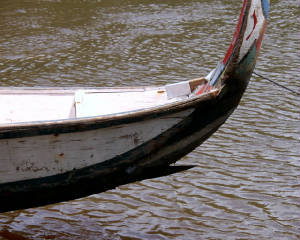
|
| Damaged keel |
The boat
was damaged but Manu, who fixes and builds everything from the forest, said that he could repair it. The engine went by plane to town the next day for repairs. Several
boats were hired from the nearest village to bring more wood and a new rebar cutter and even an electric cement mixer (that
is another story).
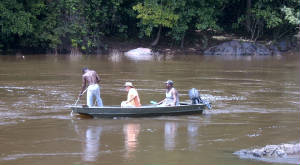
|
| Grappling for the boat cover frame |
We dragged
the river the next day with a makeshift grappling hook. We thought it would be easy to hook the roof of the boat but we didn’t
find anything. We did get a little hungry by the end of the week when the chicken
ran out but my aunt was happy as the cook started making different things from the back of the storeroom. We all enjoyed painting the boat after the hull was repaired. It
is back on the river with a repaired motor. We have no awning to protect us from
wind and rain but hopefully we will find the metal frame when the water level drops some more(see the river depth graph
above ).
Note: The
boat capsized on March 12. Although the water came down it is now way up and will probably remain so through the rainy
season.
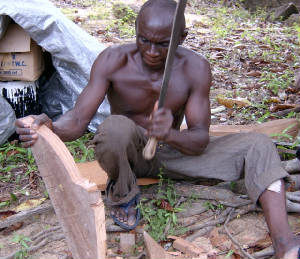
|
Manu carving a new boat rib
|
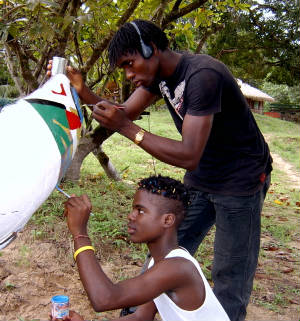
|
Bryan and Rochano repainting boat designs
|
In the middle of the Central Suriname Nature Reserve, Amazonia, South America
|

